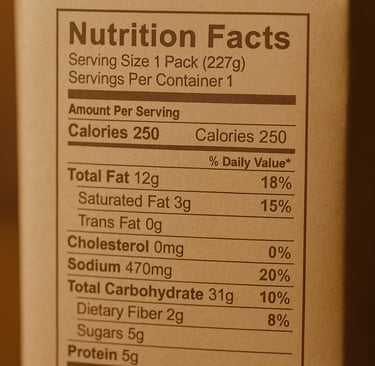How to understand the nutrient info printed on the packaging of the packaged processed food
Understanding the nutritional information on packaged food labels is essential for making informed dietary choices. These labels provide detailed insights into the food's contents, helping you assess how they fit into your overall nutrition plan. Here's a guide to interpreting the key components of nutrition labels:
1. Serving Size
The serving size indicates the recommended amount of the product to consume, reflecting typical consumption patterns. All nutritional values on the label are based on this quantity.
2. Calories
Calories measure the energy you get from a serving of the food. Monitoring calorie intake is crucial for managing weight and overall health.
3. Nutrients to Limit
It's advisable to consume certain nutrients in moderation:
Total Fat: Includes all types of fat; excessive intake can lead to weight gain and heart disease.
Saturated Fat: Found in animal products and some plant oils; high amounts can raise cholesterol levels.
Trans Fat: Present in partially hydrogenated oils; contributes to heart disease.
Cholesterol: High levels can increase the risk of heart disease.
Sodium: Excess sodium can lead to high blood pressure.
Added Sugars: Sugars added during processing; high intake is linked to obesity and diabetes.
4. Nutrients to Encourage
Look for foods rich in beneficial nutrients:
Dietary Fiber: Supports digestive health and helps control blood sugar levels.
Protein: Essential for building and repairing tissues.
Vitamins and Minerals: Important for various bodily functions; labels may list specific nutrients like Vitamin D, calcium, iron, and potassium.
5. % Daily Value (%DV)
The %DV shows how much a nutrient in a serving contributes to your daily diet, based on a 2,000-calorie reference. Generally:
6. Ingredients List
Ingredients are listed in descending order by weight, from most to least. This helps identify the primary components of the food.
7. Front-of-Pack Labels
Some packages feature symbols or ratings (like the Health Star Rating or Nutri-Score) that summarize the product's nutritional profile, aiding quick assessments.
Tips for Using Nutrition Labels Effectively:
Compare Products: Use labels to compare similar foods and choose options with better nutritional profiles.
Be Skeptical of Marketing Claims: Terms like "low-fat" or "sugar-free" don't necessarily mean healthy; check the full nutritional information.
Consider Your Dietary Needs: Focus on nutrients that align with your health goals, such as reducing sodium for blood pressure management or increasing fiber for digestive health.
By familiarizing yourself with these elements, you can navigate food labels with confidence, making choices that support your health and well-being.


